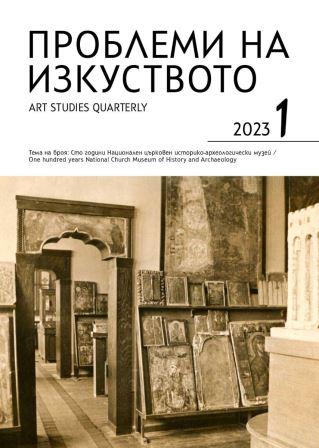Рипидите от иконостаса на църквата „Св. Димитър“ в Арбанаси и техният автор
The iconostasis’ ripidions of St Demetrius Church in Arbanasi and their author
Author(s): Maria KolushevaSubject(s): Fine Arts / Performing Arts, History of Art
Published by: Институт за изследване на изкуствата, Българска академия на науките
Keywords: post-Byzantine art; icons; murals; attribution; St Athanasius Church in Arbanasi; atelier of Nicholas of Linotopi
Summary/Abstract: The exposition of the National Church Museum of History and Archaeology (NCMHA) holds two ripidions of an iconostasis with the images of the Most Holy Mother of God and St John the Theologian, which originate from St Demetrius Church in Arbanasi. In literature, the works are dated differently – from the 16th to the beginning of the 17th century. The stylistic features of the images make them extremely close to the four icons of the Museum of Christian Art – the Crypt: the Christ Pantocrator (Megalodoros), the Virgin with the Christ Child, St George Tropeophoros and St Demetrius Great Chieftain. All of them can be attributed to the “hand” of the painter who executed the ripidions. The dating of the icons is unclear, furthermore their place of origin is generally pointed as the Tarnovo region. The execution technique of these works, as well as the relief decoration of the backgrounds, are similar to four icons painted for the royal order of the iconostasis in St Athanasius Church in Arbanasi. They were probably made around 1667 together with the frescoes in the naos and the narthex of the church in the same icon-painting atelier. This closeness imposes a review of the murals in the same church with the idea of certain proximity to the artistry of the ripidions and the icons from the Crypt. It is evident that the master who painted the ripidions and the icons from the Crypt most probably participated into the painting of the grave church of St Athanasius in 1667. There is lack of certain evidence that the icon-painters, who painted the walls of this particular church, worked also in other churches in the region. Nevertheless, literary sources suggest their participation. A number of iconographic parallels between the murals in St George Chapel at St Demetrius Church and the frescoes of St Athanasius Church show that apart from the artistry of the altar the same icon-painting team had made the second layer of frescoes in the chapel. It seems that around the third quarter of the 17th century the iconostasis/iconostases of the church (in the naos and the chapel) were renovated. From this stage of en-dowment of the church, the ripidions from NCMHA and probably the four icons of the royal order have survived to the present day. The stylistic features of the icons, which are assumed to have been made for the church of St Demetrius, show that their author worked on the frescoes in the vault of the naos of St Athanasius church. The team to which this anonymous master belonged has been identified in the literature with the atelier of the painter Nicholas of Linotopi.
Journal: Проблеми на изкуството
- Issue Year: 2023
- Issue No: 1
- Page Range: 19-29
- Page Count: 11
- Language: Bulgarian
- Content File-PDF

